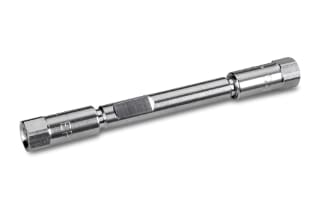
Primarily supports legacy methods. BioSuite Peptide Analysis columns consist of two premier reversed-phase column chemistries specifically optimized for peptide mapping from simple to complicated digests. BioSuite PA Columns are available in various configurations for LC or LC-MS applications, including 250 mm lengths for ultra high resolution. These BioSuite PA-A and PA-B columns provide excellent batch-to-batch reproducibility for consistent results and are uniquely QC tested specifically for peptide mapping. BioSuite C18 3 µm PA-A is a 100Å, difunctional bonded, low ligand density, silica-based reversed-phase column and BioSuite C18 3.5 µm PA-B is a 300Å, high ligand density, monofunctional, silica-based reversed-phase column.
|
Chemistry |
C18 |
|
Separation Mode |
Reversed Phase |
|
Particle Substrate |
Silica |
|
pH Range Min |
2 pH |
|
pH Range Max |
8 pH |
|
Maximum Pressure |
6000 psi (415 Bar) |
|
Endcapped |
Yes |
|
Molecular Weight Range Min |
1000 |
|
Molecular Weight Range Max |
15000 |
|
Particle Shape |
Spherical |
|
Particle Size |
3 µm |
|
Endfitting Type |
Waters |
|
Pore Size |
100 Å |
|
Format |
Column |
|
System |
HPLC |
|
USP Classification |
L1 |
|
Inner Diameter |
2.1 mm |
|
Length |
50 mm |
|
Carbon Load |
12 % |
|
UNSPSC |
41115709 |
|
Application |
Peptide |
|
Brand |
BioSuite |
|
Product Type |
Columns |
|
Units per Package |
1 pk |

BioSuite C18 PA-A Column, 100Å, 3 µm, 2.1 mm X 50 mm, 1K - 15K, 1/pk
The BioSuite C18 PA-A Column is a low-ligand density, dielectrically bonded silica-based column. It has been meticulously engineered for good polar peptide retention, making it an excellent candidate for use as a column in LC-MS applications using formic acid (FA), which decreases ion suppression. Traditional HPLC separations employing TFA concentrations, such as 0.025 percent TFA, function well with the BioSuite C18 PA-A Column.
The BioSuiteTM Peptide Analysis columns are made up of two superior reversed-phase column chemistries that are specially designed for peptide mapping from simple to complex digests. BioSuite PA Columns come in a variety of sizes and combinations for LC and LC/MS applications, including 250 mm lengths for ultra-high resolution. These BioSuiteTM PA-A and PA-B columns are QC tested specifically for peptide mapping and provide high batch-to-batch consistency for reliable results. BioSuiteTM C18 3m PA-A is a difunctional bonded, low ligand density, silica-based, reverse-phase column with a 100 ligand density, while BioSuiteTM C18 3.5m PA-B is a 300 ligand density, monofunctional, silica-based reverse-phase column with a high ligand density.
The BioSuite C18 PA-A Column column is made under the tightest cGMP, ISO 9002 conditions in a dedicated Waters chromatography chemistry production plant. Silica-based and polymeric chromatography materials are manufactured and packed into columns and solid-phase extraction devices at the manufacturing site. This assures that you receive top-of-the-line laboratory equipment that produces consistent and trustworthy analysis findings.
If you are interested in reading more about the different products manufactured by Waters, please check our website where you can shop for lab equipment or reach out to any member of our global team for assistance with other products, getting more information or sharing any concerns you might have.
You may also be interested in the Waters Black Cap and Preslit PTFE/Silicone Septum for TruView Vials, which are color-coded; black caps are spare caps for TruView LC/MS Certified Vials. The septum will enable you to replace the pre-slit PTFE/Silicone septum of the glass vials and offers sufficient venting to prevent vacuum formation in the sample vial. It delivers outstanding sample-draw reproducibility while exhibiting excellent resealing characteristics.
Why Is It Possible That A Gradient System Is Necessary?
Gradient systems are instrumental in enhancing chromatographic separations by enabling precise control over flow rate and facilitating solvent/buffer changes. They offer the flexibility to fine-tune separations and expedite column re-equilibration. A four-solvent gradient system, incorporating methanol, acetonitrile, ammonium acetate buffer, and formic acid solution, proves invaluable in method development. In quality control labs, isocratic systems are commonly employed, utilizing a premixed mobile phase of constant composition for rapid separations.